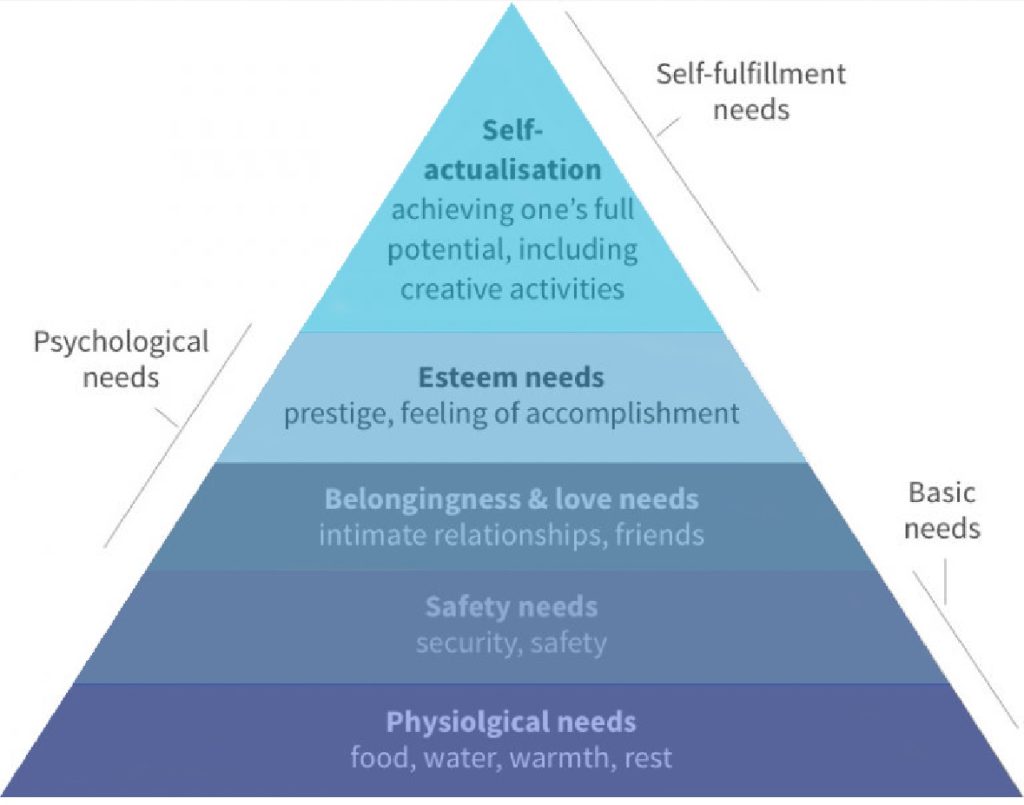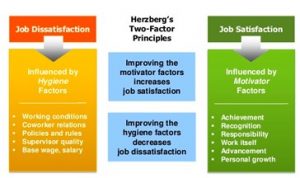Section 3.4: How to Engage Employees in the Workplace
Amarjot Uppal; Gab Sandhu; and Gurneet Kaler
Needs-based Theories
The basic concept of needs theories is that individuals are motivated to obtain outcomes at work that satisfy their needs. Therefore, needs theories attempt to identify the internal factors that motivate individuals (The Needs Theory: Motivating Employees with Maslow’s Hierarchy of Needs, 2012). Needs theories suggest that to motivate a person to contribute valuable input to a job and perform at a high level, a manager must determine what needs the person is trying to satisfy at work and ensure that the employee receives outcomes that help satisfy those needs in return. There are several needs theories, and we will be going over Maslow’s Hierarchy of Needs and the Two-Factor Theory by Frederick Herzberg.
Maslow’s Hierarchy of Needs
Abraham Maslow is a twentieth-century psychologist who is well known for his contributions to human psychology (Selva, 2020). Maslow’s hierarchy of needs is one of the best-known theories of motivation. Maslow organized human needs into a pyramid in a sequence – from the lowest level to the highest level that includes physiological, safety, belonging and love, esteem, and self-actualization needs. According to Maslow, an individual must satisfy lower-level needs before addressing the higher-level needs in the pyramid. Once a lower-level need is satisfied, it no longer serves as a motivator (MasterClass, 2020).

Physiological Needs
Physiological needs are at the lowest level of the pyramid because these needs are the most basic. These refer to the requirements for human survival such as food, water, warmth, rest and shelter. In the working industry, this translates into money. A job satisfies an employee’s basic needs when their employer pays enough money to allow the employee to afford their needs of survival such as rent, utilities and food.
Safety Needs
The next level is a feeling of safety and security. People want to feel protected and secure in their environment. In the workplace, this means that employees must be free from the threat of danger or an uncertain future. Employers should prioritize health and wellness by providing comprehensive benefit packages to employees. These benefits should include medical insurance to help cover the expenses that are not covered under the public health care plan to help satisfy safety needs.
Belongingness and Love Needs
Once safety needs have been met, the need for belongingness and love becomes more important. This includes the need to bond with other human beings, the need to be loved, and the need to form strong relationships at work (Cherry, 2020). Employers can help meet belongingness needs by providing an environment of continuous collaboration and communication with others. Furthermore, employers can host social get-togethers if they see that their employees are primarily motivated by social needs. Employers can avoid causing resentment by scheduling get-togethers at appropriate times so employees do not have to sacrifice their time off and everyone can participate.
Esteem Needs
Esteem needs are a higher level need because employees want to feel that they are making a contribution. Esteem needs refer to a person’s desire to be respected by peers, to feel important and to be appreciated. Employers can assist with esteem needs by recognizing employees’ accomplishments with meaningful job titles, perks, feedback, acknowledgement, etc.
Self-actualization Needs
Finally, self-actualization is the highest level of the hierarchy. This need refers to the desire to acquire new skills and take on new challenges to attain one’s goals. Self-actualization needs may be satisfied by opportunities at work as a means of development and growth (Komninos, n.d.). This can be done by providing tasks to employees that are challenging and interesting to promote personal and professional growth. By doing so, employees will develop an understanding that personal achievement and business achievement are linked. Interesting and challenging work is attractive to employees. Additionally, employees spend the majority of their day at work, so it is important that they leave their worksite knowing that they have made a positive contribution to the business.
Herzberg’s Two-Factor Theory
Frederick Herzberg was a clinical psychologist who is best known for his development of the two-factor theory (Toolshero, n.d.). His two-factor theory is used by organizations across the globe to increase productivity. Herzberg developed the theory based on data he collected from interviews with a large number of engineers and accountants. The purpose of the interviews was to find out what made these workers satisfied and dissatisfied on the job. He asked the employees two sets of questions. As part of his theory, he suggests that job satisfaction and job dissatisfaction both work independently of each other in the workplace.
In Herzberg’s two-factor theory, we can see that employees usually fall somewhere on two spectrums (Contributor, 2020). The first is job satisfaction or a lack of job satisfaction (motivators). According to Herzberg, motivators encourage employees to try harder at work. Motivators include achievement, interesting work, increased responsibilities, advancement, and growth opportunities. The second is feeling dissatisfied at work; or not feeling dissatisfaction at work (hygiene factors). Hygiene factors include an organization’s policies, working conditions, salary, safety, and security on the job.
Two Dimensions of Employee Satisfaction
| Maintenance/Hygiene Factors | Motivators |
| Company policy | Achievement |
| Supervisor and relationships | Recognition |
| Working conditions | Interesting work |
| Salary | Increased reasonability |
| Security | Advancement and growth |
According to Herzberg, having a work environment with high hygiene factors and motivators is important to keeping employees motivated. The following is a list of some primary hygiene and motivator factors to take into consideration:
Organizational policy
To decrease dissatisfaction, organizational policies need to be fair and apply equally to all. It is important to make written manual copies of policies and procedures to make them easily accessible to all employees and staff.
Working Conditions
Safe and comfortable working conditions are a basic need that all employees expect from their employers, and the work environment has a tremendous effect on one’s level of motivation. Providing a safe and comfortable workplace is an example of a hygiene factor. For instance, having an office that is uncomfortable can contribute to a lack of motivation.
Salary
Although salary is not a long-term motivator, it is important. Employers need to take measures to provide fair and reasonable compensation. Employees want to feel that they are being compensated well for their performance. Thus, it is also vital to have clear policies in place for salaries, raises and bonuses.
Achievement
Another premise of Herzberg’s theory is that most individuals want to do a good job at work. An employer can assist them by giving them the opportunity to work in positions that require their specific skills and talents. When setting clear goals, employees should be involved in the process and aware of what is expected of them.
Recognition
Workers at all levels of an organization want to be recognized for their achievements. Employers should keep in mind that the level of success does not have to be monumental before being deserving of recognition. Praise should be sincere, and if employers are doing well their work should be acknowledged immediately. This can be done by publicly thanking them during a meeting at the workplace or by writing them a kind note or email.
Advancement and Growth
Good performance can be rewarded with advancement to open positions that are well suited to a current employee. Also, employers can support employees by allowing them to pursue further education in order for them to feel professionally fulfilled.

Although there are many motivational theories to take into consideration, Herzberg’s theory offers a reasonable starting point for employers. By establishing a work environment that promotes job satisfaction, employees are motivated to contribute higher quality work. With high hygiene and high motivation factors, employees feel happier and more motivated because they are being treated fairly based on the above factors. With high hygiene and low motivation factors, workers tend to show up and do their job, but they will not necessarily be motivated to go the extra mile. Their job may lack motivating factors even if the workplace is fair in all aspects. The opposite of this would be low hygiene and high motivation factors, with some of the motivation factors including meaningful projects and recognition for work. On the other hand, low hygiene in this case would mean working too many hours, receiving low wages, and having an uncomfortable work environment.
Intrinsic Motivation vs. Extrinsic Motivation
Intrinsic motivation comes from within, while extrinsic motivation originates from outside. Motivational factors are intrinsic in nature, while hygiene factors are extrinsic. Intrinsic factors are related to the job, and these factors have a positive effect on job satisfaction while often resulting in an increase in total output (Cherry, 2020). Intrinsic motivation is based on the types of emotional needs identified in Maslow’s hierarchy of needs. Intrinsic factors have a positive influence on morale, satisfaction, efficiency and productivity. On the other hand, extrinsic motivators are the kinds of basic needs included in the lower levels of Maslow’s hierarchy of needs. Based on Herzberg’s theory, extrinsic motivators include status, job security, salary, and benefits. When employees are dissatisfied or feel bad about their jobs, they tend to identify extrinsic factors as the main reasons.
Image Attribution
“Maslow’s Hierarchy of Needs” by Chiquo, Wikimedia Commons is licensed under CC BY-SA 4.0
“Boundless Management” by LumenWaymaker is licensed under CC BY-SA 4.0

